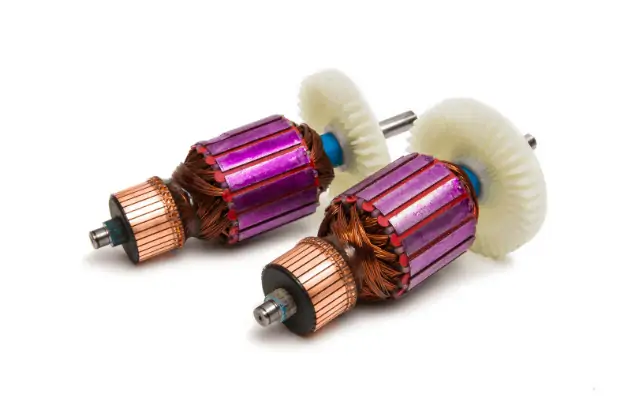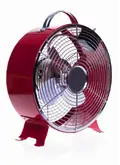A quiet shop fan has numerous benefits over a standard box or floor fan. They’re high velocity and are harder wearing, making them ideal for workshops or a garage.
In this article, I review the best picks for quiet shops fans, which I consider to be everything below 70dB.
After, I’ll go over the top features to consider when making your pick so you know exactly what to look out for.
Our Top 5
I’ve chosen my picks for best shop fans based on noise level, air circulation, durability, and ease of use. These are the most important factors when choosing a utility fan.
1. Top Pick: Vornado EXO51 Shop Fan
- Airflow: 236 CFM
- Blade Diameter: 7.2″
- Vertical Tilt: Yes
- Speed Settings: 3
- Noise Level: 57 dB
- Dust & Splash Resistant: IP54
- Weight: 7.1 lbs
Although it’s the smallest utility fan on this list, the Vornado wins top pick for several reasons. First, it’s low noise (57dB), making it a great quiet shop fan.
Also, it’s dust resistant and IP54 rated, meaning it’s splash resistant. Dust resistance is a vital feature in many work settings, particularly decorating, construction, and woodworking.
However, this does come at a price. The fan’s diameter is only 7.5 inches and it has a CFM rating of 236. Even so, many users state it’s a powerful fan for its size and so will be suitable for smaller workshops or carrying to a job site.
Along with being dust resistant, the body is made from durable plastic and steel. The fan is well suited for the workplace in this regard and even includes a hole on the back for hanging on a wall.
You can tilt the fan head to any angle and it uses something called Vortex Technology to provide better air velocity than other fans the same size. You have three speed settings controlled manually from the fan.
Users primarily critique its airflow and power levels. But, as mentioned, this is a smaller fan than other shop models, so it’s to be expected. If you need a really powerful fan, choose another. The Vornado wins on portability, though, making it great for workers on the move.
- Compact and portable utility fan – ideal for a job site.
- Water and dust resistant.
- Low noise of 57dB.
- Durable construction.
- Not as powerful as large shop fans.
2. Best Budget Pick: Lasko High Velocity Fan
- Airflow: 3460 CFM
- Blade Diameter: 20″
- Vertical Tilt: Yes
- Speed Settings: 3
- Noise Level: NC
- Dust & Splash Resistant: No
- Weight: 14.5 lbs
One of the best features of this fan from Lasko is that you can use it as either a floor fan or a wall fan. It comes with a stand and bracket, allowing you to switch depending on your workshop and needs. It’s a minor feature but is helpful nonetheless.
The maximum CFM is 3460, which is nearly half that of the DEWALT fan (reviewed below in this list). Even so, it’s still fine for cooling large workshops. Its lowest speed provides 3160 CFM, meaning there’s very little difference between the settings.
There are three speed settings, which you control manually using a dial on the power cord. The fan’s housing and stand are metal but it has rubber feet to protect surfaces. Switching between modes is easy: unscrew the mount and hang it up. The cord itself is 6ft. long, which is plenty.
Unfortunately, Lasko doesn’t provide a decibel rating. Users mention it’s surprisingly quiet for its size and airflow, so hopefully, this is enough to give you some confidence in the product. For a shop fan, it should do the job fine.
Other reviews critiqued its lack of oscillation feature, but this isn’t particularly common on utility fans. It does have a full tilt function on the head, so you at least have vertical control over where it directs air.
- Comes with a floor stand and wall mount.
- Durable metal housing – good for workshops.
- CFM of 3460 is enough for large spaces.
- 6ft. cord gives plenty of flexibility.
- No decibel rating.
- Fan doesn’t oscillate.
3. Best Lightweight Pick: Master MAC-20F Industrial Floor Fan
- Airflow: 4800 CFM
- Blade Diameter: 20″
- Vertical Tilt: Yes
- Speed Settings: 3
- Noise Level: NC
- Dust & Splash Resistant: No
- Weight: 14 lbs
This industrial floor fan from Master is the lightest large fan on this light. While weight isn’t a major factor, it does help with portability when moving to a job site. So, if the Vornado fan is too small, this is perhaps your next best option.
It weighs only 14lbs, which is quite light for a large utility fan. Its housing and stand are metal, meaning it’s still durable enough for a workshop or garage.
You get 3 speeds with a maximum CFM of 4800. While not the strongest, it’s still enough to circulate air around a large workshop or factory floor. You can also tilt the head 360 degrees to get the best airflow. It might not have the same high-velocity settings as others, but it’s good nonetheless.
Unfortunately, like other shop fans on this list, there isn’t a specific decibel rating. Luckily, previous users come to the rescue, stating it’s surprisingly quiet due to its size. Some complained it’s too loud for use in the home, but that’s because it’s a shop fan.
But, some reviews did state that it’s a bit too light for its power. This results in it moving around, even on the lowest setting. To overcome this, prop a cinder block or other heavy thing behind it. While this does make its weight somewhat redundant, people working on job sites should have no shortage of heavy things.
- Lightweight industrial fan.
- Decent airflow.
- Users claim it’s relatively quiet.
- Base is too light to support high velocity air flow.
4. DEWALT DXF-2490 Shop Fan
- Airflow: 6500 CFM
- Blade Diameter: 24″
- Vertical Tilt: Yes
- Speed Settings: 3
- Noise Level: 60 dB max
- Dust & Splash Resistant: No
- Weight: 33 lbs
DEWALT is a big name in the tools market, so it’s no surprise it makes a high-quality utility fan. This fan operates between 30 and 60dB, meaning it’s pretty quiet on all settings.
You get three speed settings up to a maximum of 6500 CFM, which is high velocity. It’s enough to provide airflow around a large workshop and so is suitable for most home and industrial applications.
Although the fan doesn’t oscillate, it has a 360-degree tilt function. This allows you to point it in whatever direction you want. You lock the fan’s head back in place using 2 bolts. In short, it’s very secure and easy to use.
It’s well suited to workshops, as it has non-slip feet, a folding carry handle and rubber wheels for transportation. The wheels are a welcomed add on as this fan is heavier than others in this list, 33 lbs versus 15lbs. The body is metal and the blades are aluminum. Finally, its power cord is 12ft. long. Overall, it’s a pretty sturdy fan.
The only downside noted by users is the fan’s noise at its most powerful speeds. A 30dB difference between high and low is quite substantial, but 60dB isn’t that loud. To avoid this, run it on the lower settings when you don’t need the max airflow.
- Well built for industrial settings.
- High CFM rating.
- Low decibel rating, even on highest speed.
- Head tilts 360 degrees.
- No oscillation.
- Large difference between noise emissions on low and high.
5. Tornado 24-Inch High Velocity Shop Fan
- Airflow: 7800 CFM
- Blade Diameter: 24″
- Vertical Tilt: Yes
- Speed Settings: 3
- Noise Level: 70 dB max
- Dust & Splash Resistant: No
- Weight: 26 lbs
At 7800 CFM, this is the most high velocity fan I’ve reviewed. Importantly, it’s best suited to very large workshops and industrial settings, and provides more fan features than other fans. It would be ideal for a larger job site, too
Unlike the Master fan, it’s appropriately weighted to deal with this high velocity airflow. It weighs 26lbs, which is quite heavy, but at least means it won’t walk around your workshop when providing maximum air circulation.
Its noise emissions are around 70dB, which puts it at the higher end of the spectrum. But, once you balance this against workshop noises, it’s really not that bad.
The fan is UL listed, which is an American safety standard. It’s suitable for use in commercial workplaces as a result. It’s compliant with other safety standards, including the OHSA.
It comes with rubber wheels and non-slip feet that make it easy to move around the workshop floor. There’s even a helpful carry handle on the top to make pulling it easier. Finally, the 8ft. power cord and rust-resistant grille make it durable enough for workplaces.
Users praised the ease of assembly but critiqued the fan’s operation. They state it gets quite hot after a few hours on the high setting and so is a bit troubling to leave alone. To be on the safe side, consider plugging it into a surge protector outlet.
- Most high velocity shop fan I reviewed.
- Heavy but portable.
- UL listed and OHSA compliant.
- Easy to assemble.
- Loud for a quiet shop fan.
- Gets hot after operating for a few hours.
What Affects the Noise Level of a Shop Fan?
When it comes to buying a high-velocity fan, there are plenty of things to consider that affect the overall noise emissions. I consider the following to be the most important factors.
Decibel Rating
We’ll start with the obvious: knowing a decibel rating is clearly the easiest way to decide on the best models. I recommend choosing a fan with a maximum of 70-75dB depending on your purposes.
This is the equivalent of a residential washing machine. Anything less than this will do the job.
Of course, it’s worth factoring in how much noise you’re making while working. For example, operating machinery or power tools will allow you to run a louder fan because you won’t notice the noise.
But, if you’re a decorator or want the fan for use in your garage, you’ll want to aim for a quieter one.
Most manufacturers seem to work with this logic, as not many include a specific decibel rating. In these situations, the best thing to do is look at user reviews. If a fan is louder than it reasonably should be, you can guarantee that people will let you know.
Build Quality
Build quality is vital when buying any electrical device. Cheap parts and assembly mean poorer operation, shorter lifespan, and often higher running costs.
But, what does good build quality look like in a shop fan?
Housing
A shop fan should be made of metal. You’ll find models with a drum body or with a grille. Both are fine for industrial settings, but a drum is more durable because it’s a solid ring of metal rather than thin metal bars.
Steel and aluminum are the best materials to look for and are luckily quite common in industrial fans. Try to avoid plastic (unless it’s impact resistant), as it often implies lower build quality.
Motor
The motor relates to both build quality and noise emissions. A ball bearing motor is common on shop fans because it’s suitable for workplace applications. A ball bearing motor is:

- More resistant to temperature fluctuations
- More durable than sleeve bearings and other motor types
- Quieter than other motor types
I’ve tried to review fans with a ball bearing motor wherever possible for these reasons. Of course, it’s not the only motor type, but it’s the best way to guarantee functionality and longevity.
Number of Blades
Fans with more blades are generally quieter because they don’t move as fast to circulate as much air. It comes at the expense of being marginally less efficient, though.
With shop fans, you’ll be choosing between 3 and 5 blades. At the size and power levels we’re considering, the number of blades doesn’t make a massive difference.
But, if possible, aim for a fan with 5 blades rather than 3. It’ll allow you to get more airflow at lower speeds, which I discuss more below.
Speed Settings
Speed is obviously an important factor when choosing any fan, but is even more important for a quiet shop fan. You want a fan that moves enough air (measured in cubic feet per minute – CFM) but is quiet enough.
A faster-moving fan produces more noise; this much should be obvious. The noise of the airflow contributes to overall noise levels, but not by much.
When choosing a quiet shop fan, you’ll want at least 3 speed settings. This should give you enough flexibility over the level of airflow.
But, buying a fan that’s more powerful than your requirements allows you to run it on a lower setting. In turn, this means the fan itself produces less noise.
For example, if you need 3000CFM for your room, consider jumping up to a maximum of 4000 – or even 6000. Doing so means you run the fan on its lowest settings.
If you’re unsure what CFM rating you need, use this calculator.
Features to Consider
Shop fans are designed for use in a garage, workshops, factories, and so on. As a result, you need to consider different criteria than when you’re buying a fan for your home.
Here are my main factors when selecting quiet shop fans.
Tilt
You won’t find oscillation features on shop fans because most are freestanding rather than on pedestals. Instead, they usually have a tilt function.
It allows you to rotate the head on the stand to direct airflow. Ideally, look for fans with a 360-degree rotation and a secure locking mechanism. It’s often some bolts that you screw into place.
Tilting the head is enough to circulate air in whatever direction you choose. Combined with a shop fan’s high velocity, it should be enough to move air around larger spaces.
High Velocity
Most quiet shop fans are labeled as high velocity. But what does that mean?

High velocity air flow pushes out more air in a shorter space of time, hence their higher CFM ratings. But, they’re also designed to project air across larger distances, making them suitable for a workshop or garage.
They achieve this by combining a powerful motor and large fan blades. It’s why many of the shop fans reviewed above are 20 inches or more.
There’s no hard and fast answer for relating a high velocity fan to the size of your workplace. The calculator linked above will give you the minimum requirements but doesn’t factor in high velocity air flow.
Just work with the simple logic that larger spaces require a higher CFM rating. A high velocity fan means better air circulation outdoors, too.
Portability
A fan’s portability depends on your needs. For example, if you’re fitting out a workshop or garage at home, you need less portability than, say, a painter.
All shop fans are technically portable. If it’s on a stand, you can pick it up and position it where needed. Of course, this isn’t very efficient if you move around regularly.
Portable shop fans have wheels, a grip handle, and feet. Look for wheels and feet made of rubber. Rubber feet stop the fan from slipping and ensure surfaces don’t get damaged.

Weight is worth considering, too, but isn’t as important. Most fans weigh roughly the same (around 10-15 lbs.) unless they’re smaller models. Be sure you can carry the fan along with your other tools.
Finally, some fans include a wall mounted option. It’s a bracket that you screw into the wall or might be a screw hole in the fan’s housing. A wall mounted fan is good for circulating air higher up than a floor fan. If you’re looking for wall mounted options, I’ve written a dedicated article.
Dust Resistance
Not everyone will need a fan that’s water and dust resistant, as it depends on the kind of work you do. Some shop fans are IP rated, which is its measure of water and dust resistance.
If not, look for helpful signs that it’s more resistant, such as:
- Encased motor
- Easy to disassemble for cleaning
- Comments from other users
Safety Features
Safety features are often necessary when taking devices into a commercial workplace. While the site might have its own tests, many use UL and OSHA. A good utility fan will list whether it’s compliant, but also look out for:
- A grounded power cord
- Blade housing
- Rubber feet (prevent slipping)
- Surge or overheating protection
Final Thoughts
Hopefully, this article has given you some inspiration for choosing the best quiet shop fan for your needs.
My top pick is the Vornado EXO51 Shop Fan. While it’s the smallest one I reviewed, it’s highly portable, quiet, and still powerful enough for a smaller workshop or garage.
If it’s too small for your needs, the Lasko or DEWALT fans are also great picks.
What are your most important factors when choosing a utility fan? Let me know in the comments below.





